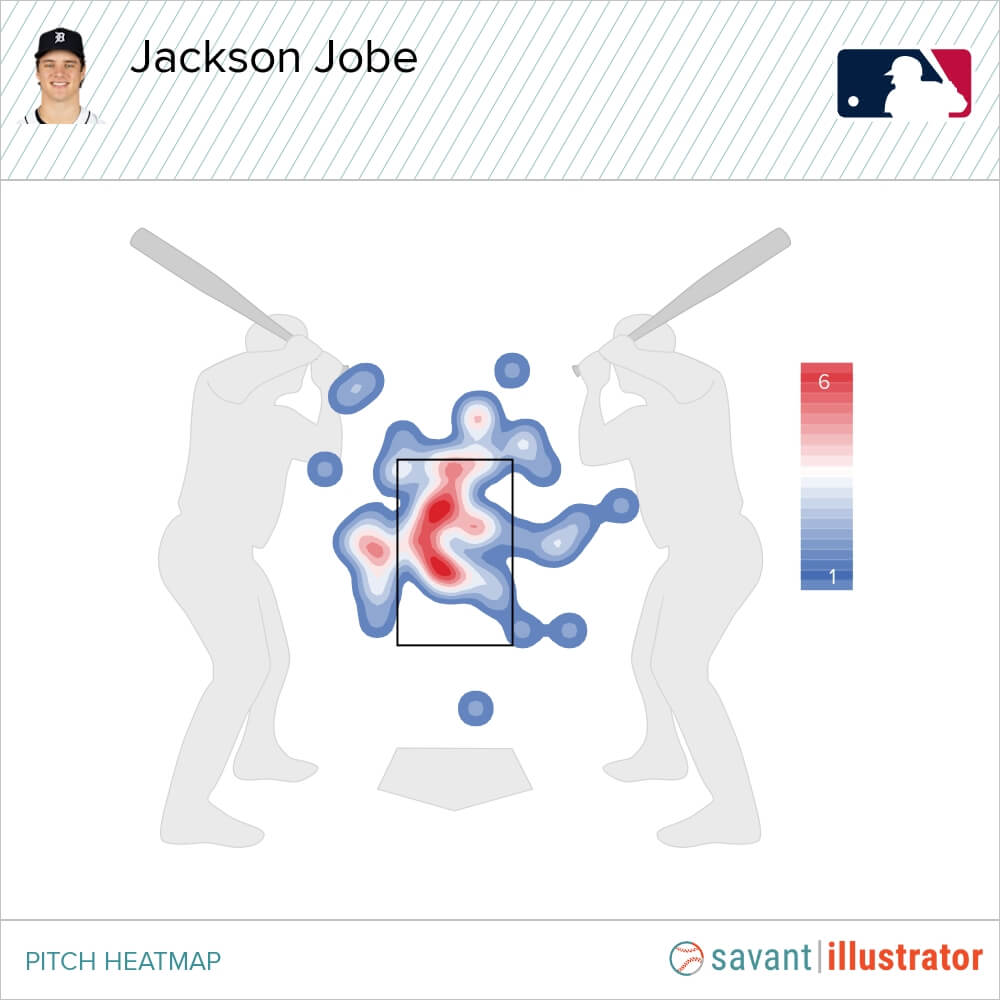
It’s still impossibly early. That struggling hitter or pitcher could turn it around next time out, and the narrative could change regarding their season. Just ask Rafael Devers.
When it comes to pitching, we can at least look at the physical characteristics of pitches, which are very steady compared to the rapid ebbs and flows in results. With the help of the predictive power of Stuff+, we can ask the data to show us who is throwing the right shapes and velocities with poor results and, thus, who should eventually turn it around.
So, who has pitched twice with an ERA over 5.00 and Stuff+ over 100? It’s a fascinating list.
Good Stuff+, bad results
| Pitcher | Team | Innings | Stuff+ | ERA |
|---|---|---|---|---|
|
CLE |
10.2 |
103 |
8.44 |
|
|
BOS |
9.2 |
100 |
6.52 |
|
|
PHI |
11.1 |
103 |
6.35 |
|
|
SEA |
11.0 |
100 |
5.73 |
|
|
ATL |
10.0 |
102 |
5.40 |
|
|
NYY |
17.1 |
116 |
5.19 |
|
|
PIT |
8.2 |
107 |
5.19 |
|
|
DET |
9.0 |
109 |
5.00 |
This list runs the gamut from established starters to top prospects to recently converted relievers. Let’s pick a few to highlight, even if they should perform better as a group going forward.
Carlos Rodón, Yankees
Despite a downturn in velocity — he’s currently at 94 mph after averaging 95.2 mph in April last year — the model likes what Rodon is throwing from a stuff perspective. That’s probably because he’s added a usable sinker and has become more of a five-pitch guy with the Yankees. A larger arsenal has been a blessing and a curse for the lefty, though. His high walk rate right now is no accident. While location numbers aren’t super useful in small samples, they tell us something in multi-year trends, and they tell us Rodon can’t control his changeup. That’s a problem because he’s using it more than he has in the past five years. Take a look at where the lefty has thrown his changeups this year:

That’s a lot of wasted effort a foot outside the zone. While you don’t want all your changeups in the zone, it’s telling that he’s managed to throw only 10 percent of his changeups in the strike zone, or worst in the big leagues among pitchers who have at least thrown two in the strike zone. That he’s still getting swings on the pitch is remarkable, but he’s also added 17 balls to the ledger this year so far, which adds up.
Advertisement
The good news is that he has in his arsenal another high-stuff secondary pitch he can feature more, one he’s shown better command of over the past five years — the curve. An 81 mph pitch with 10 inches more drop than his slider is a good breaking ball, and he’s shown around average command of the pitch while in New York. In San Francisco, Rodón was a two-pitch pitcher, but this new version has options at the ready if he can’t command the changeup.
Bryce Miller, Mariners
Though he was obviously a little dejected after his poor start against the Giants this past week, Miller knew what he would work on between starts.
“Fastball command. I always have my fastball command, and it just wasn’t quite there yesterday, for whatever reason,” he said after Saturday’s 4-1 loss.
So far, the Location+ on his fastball is 87, and it’s been 107 over his career to date, so the numbers back him up. We’re not talking about missing by huge amounts, either. Here’s a pitch where Miller may have missed his spot by 3 or 4 inches; it was just a little low in the strike zone when he wanted it at the very top.
It’s still a good fastball, and Miller has worked hard to push the size of his arsenal — it’s all the way up to seven pitches now, with a cutter he was using in the spring perhaps coming at any moment — so he’ll probably be fine in the long run. Maybe his command will improve with the weather.
Tanner Houck, Red Sox
After a breakout last year that saw Houck throw over 175 innings of near-3.00-ERA ball, the tall righty hasn’t followed up with immediate success this season. This, despite an uptick in velocity and nearly identical Stuff+ numbers, should make it tempting to shrug it all off. But there are a few warning signs. Beyond the fact that his strikeout and walk rates are unimpressive this year, there’s the underlying stuff.
Advertisement
Pitchers with arm slots as low as Houck’s are vulnerable to big platoon-split differences. Right-handers can’t see the ball all that well as he’s releasing it in their peripheral vision, but left-handers can see it pretty well. Last year, Houck was able to counteract his long-time platoon split issues and actually coaxed worse production out of lefties than righties, perhaps by changing his location strategies on his pitches. But this year, lefties are slugging a ridiculous .947 against him. Even if that’s not where it’ll end up for the year, he may always be vulnerable against opposite-handed hitters. Here’s his Stuff+, but broken up against lefties and righties.
Tanner Houck’s stuff vs. left & right
| Pitch | Handedness | Thrown | Stuff+ |
|---|---|---|---|
|
Splitter |
same |
7 |
125 |
|
Sweeper |
same |
28 |
121 |
|
Sinker |
same |
34 |
111 |
|
Four-seam |
same |
4 |
100 |
|
Sweeper |
opposite |
39 |
101 |
|
Splitter |
opposite |
31 |
75 |
|
Four-seam |
opposite |
11 |
74 |
|
Sinker |
opposite |
17 |
74 |
Sweepers have big platoon splits, maybe because their movement has the same side-to-side profile that seems to make sidearmers vulnerable to platoon splits, and the sweeper is the only pitch he has that’s a positive against lefties by Stuff+. Even the splitter isn’t judged to be a great platoon neutralizer by this model, maybe because there are only about 3 inches of movement difference (and a velocity difference of 5 mph) between his sinker and his splitter. That’s below average for the league. Houck doesn’t have a great pitch for lefties. (This is the same issue for Luis L. Ortiz, though Ortiz’s fastball and change are closer to average, and his arsenal is larger, so maybe he has more paths forward to success.)
The good news is that nothing has really changed for Houck. But that’s the bad news too — he was probably a little lucky against lefties last year, and he will likely struggle to get them out this season. He’s not a lock as a buy-low.
Jackson Jobe, Tigers
Theoretically, Jobe has everything he needs to get out lefties and righties. Against lefties, every pitch has better than a 108 Stuff+, and against righties, his fastball, sinker, and cutter all rate 114 or better. This isn’t just some statistical anomaly. He was the Tigers’ top prospect and sits 96+ mph on the fastball with good ride and pairs it with an 89 mph cutter that gets 5 inches more horizontal movement than average and a big 81 mph curveball. It’s disappointing that he has only a 17.5 percent strikeout rate and an ERA of 5.00.
Could the rookie be overthrowing?
Advertisement
It’s a lot to have on your shoulders, coming into the big leagues with expectations and stuff the models love. So it makes sense that he’s throwing close to his maximum velocity, but that’s a little dicey on two fronts. For one, throwing close to your max — and Jobe is sitting within 2 mph of his maximum this season, and that’s closer than average even in a league throwing closer to its average every year — is stressful for the elbow ligament. And secondly, throwing at the top end of your ability velocity-wise can lead to lesser command. Since he arrived in the high minors, we’ve seen Jobe’s walk rate explode. And this is his heat map for four-seamers so far this year:

That’s a lot of middle-middle.
The model would say Jobe shouldn’t throw as many curves and sweepers and should slim down the repertoire, and maybe that could be part of the answer. Simplify things, breathe, get a little taste of success, find that confidence and then start expanding the arsenal. Jobe is still exciting, but young starting pitchers often struggle before they figure it out.
(Top photo of Bryce Miller: Thearon W. Henderson / Getty Images)
This news was originally published on this post .






Be the first to leave a comment